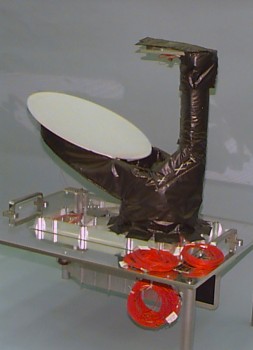Rosetta’s MIRO instrument has detected an increase in the rate of water vapour coming from comet 67P/Churyumov-Gerasimenko over the past three months. This was reported by the MIRO team at the European Planetary Science Congress last week.

The Microwave Instrument for the Rosetta Orbiter (MIRO). The radio telescope has a diameter of 30 cm.
MIRO first detected water vapour from the coma of comet 67P/C-G in June this year, when Rosetta was 350,000 km from the comet nucleus. At that distance, the nucleus was unresolved and the entire coma filled MIRO’s field of view. Now that Rosetta has rendezvoused with the comet, MIRO has begun observations to map the nucleus and coma in great detail.
During the Rosetta Special Session at the EPSC meeting, the MIRO team reported measurements made during the past three months that show that the amount of water vapour coming from the comet appears to vary as the nucleus rotates. They have measured a maximum rate of about 5 litres per second being lost by the comet, with an average rate of roughly 1 litre per second. This is markedly more than the comparatively modest rate of 300 millilitres per second measured in June.
Theoretical models predict that most of the water in the comet’s coma should exist over the sunlit side of the nucleus. Rosetta has mostly been flying over the sunlit side to date, and MIRO’s measurements are consistent with these predictions. But when Rosetta makes a flight over the night side of the comet later this month, MIRO will have the chance to directly measure the water production rate there.
In addition to water, the MIRO team have also detected ammonia and methanol, but somewhat to their surprise, they have yet to find evidence for carbon monoxide.
MIRO is also able to probe the temperature below the surface of the comet’s nucleus. At this stage, MIRO has measured subsurface temperatures between a maximum of 160 K and down to below 30 K. The coldest temperatures are associated with regions on the comet that are in darkness – the night side, areas on the sunlit side where shadows are produced by the local landscape, or in polar regions which have been in darkness for a few years.
The MIRO team estimates that they are probing a few centimetres beneath the surface or deeper. At a later stage, MIRO subsurface temperatures and VIRTIS surface temperatures will be combined to refine this estimate. With these measurements in hand, they will be able to calculate the temperature gradient in the nucleus, providing indications of the material that lies beneath the surface.









Discussion: 12 comments
Should we expect sublimating ice on the dark side? where would the heat come from?
Perhaps stored heat energy in the non-water comet surface materials would cause sublimation after dark, similar to the steam from hot asphalt after an evening rain?
5liters per second peak and 1 liter per second average tells me a lot but for the rest of the audience it would be fair to say how this water vapor is spread out over the giant volume of the tail with a figure of its highest density or equivalent pressure measured in nano bar.
Are we measuring hydroxyls, or water stretching bands ?
A lot of the jets imaged by the Epoxi mission were coming out of shaded areas.
https://epoxi.umd.edu/
So atmospheric heat transfer is negligible.
What I saw at:
https://www.esa.int/var/esa/storage/images/esa_multimedia/images/2014/09/comet_on_5_september_2014/14804076-1-eng-GB/Comet_on_5_September_2014.jpg
had me expecting much more than 3.6Tons/hour.
Really surprised.
If maximum being 160K then electric processes should have relevance.
Electric flows could easily explain some hot spots inside such a cold construct. Besides, the high thermal insulation proposed, could explain accumulation of heat. Electric flows could explain a lot more…
We have not yet got the accurate temperature gradients, but its difficult to imagin the heat getting to deep.
If as postulated the rock is porous then radiation through the vacuum of the porus bit probably wont amount to much. Also the conductivity of the black scarred surface probaly not that great either.
However as a black body absorbing almost all the energy it gets, it may also have a high heat capacity that could provide energy for a reasonable period in the dark.
Who knows with out figures?
What are the figures
And eventually is there enough solar energy at the moment to drive that coma and change solid ice to vapour.
I guess some one is doing the sums
Charge inducted? Ion output giving us current? Electro-chemistry?
Do the hydroxls add up to water or is there an unaccounted for odd mix of oxygen and hydrogen that does not support a water ice origin
The Epoxi mission showed the Hartley-2 nucleus had water vapour and methanol coming from its “neck” region and carbon monoxide/dioxide plus water vapour from its “head” region (here I am transposing terminology between the two comets). Considering the absence of CO detection so far from 67P/CG, and the existence of pits close to the J site in the head region, we may expect as the comet moves closer to the Sun, active CO/CO2 emission not far from the J site. If there are quakes the Consert experiment may detect them. So it looks like Philae may be in for exciting times.